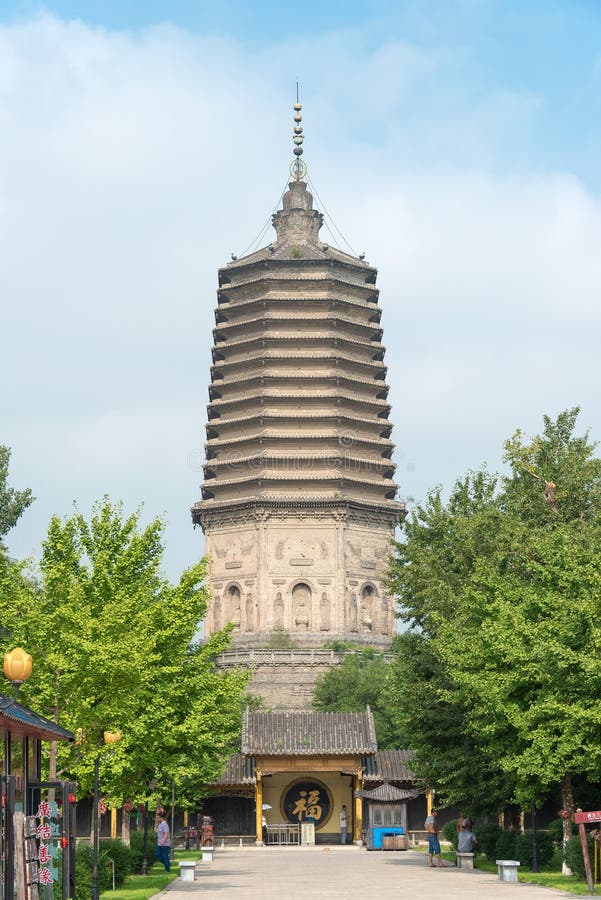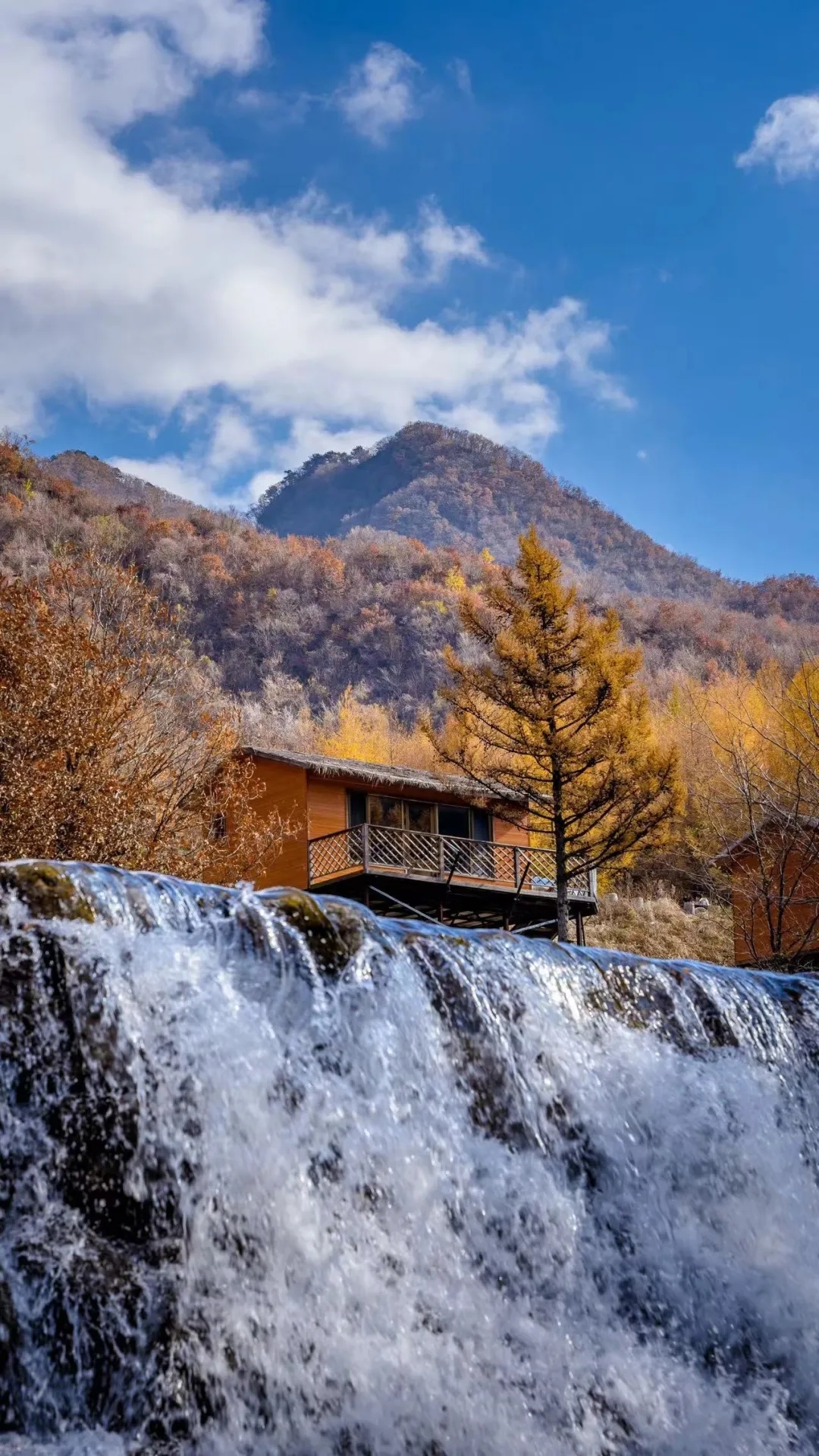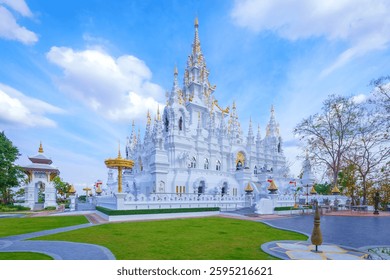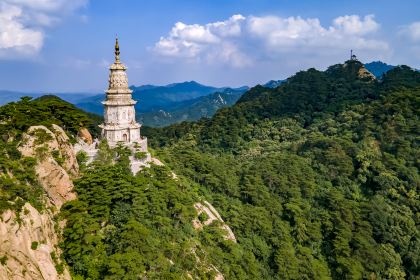Experience Tranquility at Liaoyang White Pagoda: Your Ultimate Travel Destination

An Essential Guide to Visiting Liaoyang_White_Pagoda
Nestled in the heart of Liaoyang, the White Pagoda stands as a sentinel of history, marveling visitors with its striking architecture and profound cultural significance. As one of the six tallest pagodas in China, this majestic structure, originally built during the Liao and Jin Dynasties, offers a glimpse into the rich tapestry of Northeast China’s past. Known locally as the “White Pagoda” due to its chalk-painted exterior, this 70.4-meter tall octagonal wonder boasts thirteen stories adorned with intricate brick carvings depicting seated Buddhas, celestial beings, and ornate wind chimes.
Set within the serene confines of Baita Park, the pagoda serves not only as a historic landmark but also as a spiritual haven where visitors can immerse themselves in the tranquility of its surroundings. Climbing to its summit rewards intrepid explorers with breathtaking views of the confluence of the Liao and Taizi Rivers, making it a perfect spot for photography enthusiasts seeking to capture the essence of Liaoyang.
Visiting the White Pagoda is more than just an architectural journey; it is an invitation to connect with the ancient traditions of Buddhism that echo through its halls. Whether you are marveling at its exquisite craftsmanship or enjoying a leisurely stroll in the lush park that envelops it, the White Pagoda promises an unforgettable experience steeped in history and beauty. So lace up your walking shoes and prepare to step into a world where the past meets the present, right in the heart of Liaoyang.
In This Guide
- An Essential Guide to Visiting Liaoyang_White_Pagoda
- The Rich History and Legends of Liaoyang_White_Pagoda
- Main Highlights: What You Absolutely Can’t Miss
- Planning Your Visit: A Practical Guide
- Tickets: Prices, Booking, and Tips
- How to Get There: A Complete Transportation Guide
- Local Cuisine and Accommodation Nearby
- Frequently Asked Questions
- Final Thoughts on Your Trip
The Rich History and Legends of Liaoyang_White_Pagoda
Nestled in the heart of Liaoyang, the magnificent White Pagoda, known locally as Baita, stands as a testament to the city’s rich historical tapestry. This architectural marvel, towering at 70.4 meters, is one of the tallest brick pagodas in Northeast China and is renowned for its unique octagonal shape and intricate design, which has captivated visitors for nearly a millennium.
The origins of the White Pagoda date back to the Liao and Jin Dynasties. Initially constructed in 1013 AD, it was originally named the Guangyou Temple Pagoda, reflecting its connection to the nearby Guangyou Temple, which is one of the oldest and most significant Buddhist sites in the region. The pagoda’s striking white exterior, achieved through a layer of chalk, led to its affectionate moniker, the “White Pagoda.”
Over the centuries, the structure has undergone numerous renovations, yet it remarkably retains the architectural style of its original construction. The pagoda features 13 stories adorned with exquisite brick carvings depicting seated Buddhas, attendants, and celestial beings, showcasing the artistic mastery of the era. Each level is decorated with wind chimes and bronze mirrors, while the pinnacle is crowned with gilded bronze elements, including brake poles and orbs, contributing to its ethereal beauty.
According to local legends, the pagoda was built by Wanyan Yong, a prince of the Jin Dynasty, in 1156 as a homage to his mother. This adds a layer of personal significance to the structure, intertwining familial love with architectural grandeur. The tower serves not merely as a relic of the past, but as a symbol of devotion and reverence that resonates deeply with visitors and locals alike.
As you explore the White Pagoda, you’ll discover that it is not just a monument but a cultural hub that has witnessed the ebb and flow of history. It stands amidst the serene Baita Park, where its majestic silhouette is beautifully mirrored against the sky, inviting travelers to climb its heights for panoramic views of the confluence of the Liao and Taizi Rivers.
For those eager to delve deeper into Liaoyang’s rich history, the White Pagoda offers an enchanting glimpse into the architectural and spiritual heritage of the region. Whether you’re drawn by its historical significance, architectural beauty, or the legends that surround it, the White Pagoda promises an unforgettable experience that bridges the ancient and modern worlds.

Liaoyang_White_Pagoda.
Main Highlights: What You Absolutely Can’t Miss
Nestled in the heart of Baita Park, the Liaoyang White Pagoda is an architectural gem that stands as a testament to Northeast China’s rich cultural heritage. This majestic structure, the tallest brick pagoda in the region, beckons visitors with its unique design, historical significance, and stunning surroundings. Here are the main highlights that you absolutely can’t miss when visiting this iconic landmark.
A Glimpse into History
Constructed in 1013 AD, the Liaoyang White Pagoda, originally known as the Guangyou Temple Pagoda, boasts a history that stretches back over a millennium. Its enduring presence is a symbol of the city’s storied past, reflecting the architectural styles of the Liao and Jin Dynasties. As one of the six tallest pagodas in China, it has been recognized as a national key cultural relic protection unit, making it a must-see for history enthusiasts.
Architectural Marvel
Standing at an impressive 70.4 meters, the pagoda features an octagonal structure with 13 tiers of dense eaves, which gracefully recede layer by layer. The intricate design is adorned with exquisite brick carvings depicting seated Buddhas, celestial beings, and attendants that showcase the high artistic level of ancient craftsmanship. Don’t forget to admire the gilded bronze brake poles and the delicate wind chimes that enhance its enchanting ambiance.
Scenic Views
Climbing to the upper levels of the pagoda rewards visitors with panoramic views of Liaoyang and the confluence of the Liao and Taizi Rivers. The sight of the rivers winding through the landscape is particularly breathtaking at sunrise or sunset, making it an ideal spot for photographers and nature lovers alike.
Tranquil Surroundings
The White Pagoda is situated within Baita Park, a serene environment perfect for leisurely strolls. The park’s lush greenery and tranquil pathways complement the pagoda’s grandeur, providing an inviting space for relaxation and reflection. Consider bringing a picnic to fully enjoy the peaceful ambiance.
Cultural Significance
Adjacent to the pagoda is the Guangyou Temple, the largest Buddhist temple in Northeast China, dating back to the Eastern Han Dynasty. Visitors can immerse themselves in the spiritual atmosphere, experiencing the profound Zen traditions that have been preserved through centuries. The morning bell and evening drum rituals are particularly moving, offering a genuine glimpse into Chinese Buddhist practices.
Free Admission
One of the most appealing aspects of the Liaoyang White Pagoda is that it offers free admission, making it accessible to all travelers. This allows you to explore the pagoda and its surroundings without the worry of entrance fees, encouraging you to spend as much time as you desire soaking in the history and beauty.
Perfect Timing
For the best experience, plan your visit early in the morning or late afternoon. The lighting during these times adds a magical quality to the pagoda and the park, perfect for photography and enjoying the serene atmosphere.
Visiting the Liaoyang White Pagoda is not just an exploration of a historic monument; it’s an immersion into the rich tapestry of Northeast China’s cultural heritage. Whether you are an avid historian, a photography enthusiast, or simply seeking a peaceful retreat, this iconic pagoda promises an unforgettable experience.

Liaoyang_White_Pagoda.
Planning Your Visit: A Practical Guide
Visiting the Liaoyang White Pagoda is a journey into the heart of Northeast China’s rich cultural tapestry. Nestled in Baita Park, this ancient structure is not only an architectural marvel but also a serene place for reflection and admiration. Here’s everything you need to know to make the most of your visit.
Getting There
The Liaoyang White Pagoda is conveniently located at No. 60, Section 1, Zhonghua Street, Baita District, Liaoyang City. The pagoda is just a 10-15 minute walk from Liaoyang Station, making it easily accessible for travelers. If you prefer public transport, local buses frequently service the area.
Opening Hours
While the pagoda itself is open to the public, it’s best to visit during daylight hours for the most stunning views and photographs. The site is generally accessible from early morning until dusk.
Admission Fees
One of the most appealing aspects of the Liaoyang White Pagoda is that admission is free. This allows visitors to enjoy its beauty without any financial barrier.
Recommended Duration
Plan to spend about one hour at the White Pagoda. This should give you ample time to explore the structure, take photographs, and perhaps enjoy the tranquility of the surrounding park.
Best Times to Visit
- Photography: The best times to capture the pagoda’s beauty are one hour after sunrise and one hour before sunset. The golden light during these times enhances the intricate details of the structure.
- Avoid Crowds: To enjoy a more peaceful experience, consider visiting on weekdays rather than weekends.
What to See
- The Pagoda: Marvel at the octagonal 13-story structure, standing at 70.4 meters tall. Each level features delicate brick carvings and ornamental wind chimes.
- Guangyou Temple: Just a short walk away, this significant Buddhist temple complements your visit to the pagoda. Immerse yourself in its historical ambiance and serene courtyards.
Nearby Attractions
Liaoyang is steeped in history and culture. After visiting the White Pagoda, consider exploring:
– Liaoyang Museum: Discover artifacts from the region’s rich history.
– Ancient City Wall: A short distance away, these remnants of the past offer a glimpse into the city’s historical fortifications.
Accessibility and Amenities
The park surrounding the pagoda is well-maintained, providing pathways for easy navigation. There are rest areas for visitors to relax and enjoy the view. For refreshments, local eateries are available nearby, serving traditional Liaoyang dishes.
Travel Tips
- Transportation: Consider purchasing a transportation card for convenient bus travel around Liaoyang.
- Reservations: If you plan to visit Guangyou Temple, check if reservations are required, especially during festivals.
- Photography Gear: Bring a good camera or smartphone to capture the intricate details of the pagoda and the scenic views from its vicinity.
Conclusion
A visit to the Liaoyang White Pagoda is not just a sightseeing trip—it’s an opportunity to connect with the rich history and culture of Northeast China. With its stunning architecture, serene surroundings, and free admission, this site is a must-visit for anyone exploring the area. Enjoy your journey through time at this remarkable landmark!

Liaoyang_White_Pagoda.
Tickets: Prices, Booking, and Tips
Visiting the Liaoyang White Pagoda is a remarkable experience that immerses you in the rich history and cultural significance of this architectural gem. Travelers will be pleased to know that admission to this awe-inspiring landmark is completely free. This allows everyone to appreciate its majestic presence without any financial barriers.
Booking and Access
While no tickets are required for entry, it’s advisable to plan your visit during less crowded times for a more serene experience. The best visiting hours are early in the morning or late in the afternoon, just before sunset. These times not only provide the most picturesque views but also allow you to avoid the peak tourist rush.
Tips for a Memorable Visit
-
Optimal Photography: For the best photographs, aim to visit one hour after sunrise or one hour before sunset. The soft lighting during these times enhances the pagoda’s intricate details and stunning architecture.
-
Guided Tours: Although the pagoda does not require tickets, consider joining a guided tour to enrich your understanding of its historical context and architectural significance. Many local guides offer insightful tours that cover the surrounding areas, including the nearby Guangyou Temple.
-
Stay Informed: While the pagoda itself is free to enter, be aware that certain events or special ceremonies at Guangyou Temple might require advance reservations. It’s wise to check in advance if you plan to participate in such activities.
-
Transportation: The Liaoyang bus system is reliable and covers major attractions, including the White Pagoda. Purchasing a transportation card can make your travel around the city more convenient.
-
Biking Options: If you’re up for some adventure, consider renting a bicycle or electric scooter to explore the scenic spots near the pagoda, particularly the beautiful Taizi Island Ten-Mile Gallery.
By following these tips and planning ahead, your visit to the Liaoyang White Pagoda will not only be enjoyable but also deeply enriching. Embrace the opportunity to explore this historical treasure at your own pace!
How to Get There: A Complete Transportation Guide
To reach the stunning Liaoyang White Pagoda, located in the heart of Liaoyang City, you have several transportation options that cater to international travelers. Here’s a comprehensive guide to ensure your visit is smooth and enjoyable.
By Air
The nearest major airport to Liaoyang is Shenyang Taoxian International Airport (SHE), approximately 100 kilometers (about 62 miles) away. From the airport, you have a few viable routes:
– Airport Bus: Take the airport shuttle bus to Shenyang city center, then transfer to a train or bus heading to Liaoyang.
– Taxi or Rideshare: Book a taxi or rideshare service directly from the airport to Liaoyang. This option is more convenient but will be pricier.
By Train
Liaoyang is well-connected by train, making it easy to reach from major cities in China:
– High-Speed Trains: If you’re traveling from Beijing or Shenyang, opt for a high-speed train. The journey from Beijing takes around 4 hours, while from Shenyang, it’s about 1 hour. Trains arrive at Liaoyang Station, which is conveniently located near the White Pagoda.
– Local Trains: Intercity trains from nearby cities also run frequently. Check the schedule ahead of time for the best options.
By Bus
Long-distance buses are another excellent way to reach Liaoyang:
– Intercity Buses: Various bus services operate from cities like Shenyang and Dalian to Liaoyang. Buses arrive at the Liaoyang bus station, from where you can take a local taxi or bus to the White Pagoda.
– Local Buses: Liaoyang has a local bus system that connects various districts. You can take a bus from the bus station to the Pagoda Park area.
Getting to the White Pagoda
Once you arrive in Liaoyang, getting to the White Pagoda is quite straightforward:
– Walking: If you are arriving at Liaoyang Station, the White Pagoda is about a 10-15 minute walk. Simply head south on Zhonghua Street, and you will find the pagoda in Baita Park.
– Taxi: Taxis are readily available throughout the city. A short ride from the station to the pagoda should cost around CNY 10-15.
– Local Buses: Several local bus routes can take you close to the pagoda. Look for buses that stop at Bai Ta Road or Baita Park.
Additional Tips
- Transportation Card: Consider purchasing a local transportation card for easier access to public buses, which can save you money during your stay.
- Timing Your Visit: The best times for photography at the White Pagoda are shortly after sunrise and just before sunset. Plan your transportation accordingly to enjoy these magical moments.
- Cultural Considerations: If you plan to visit Guangyou Temple after the pagoda, be aware that advance reservations may be required for special ceremonies, especially during festivals.
With this guide in hand, you’re all set to explore the breathtaking beauty and rich history of the Liaoyang White Pagoda. Safe travels!

Liaoyang_White_Pagoda.
Local Cuisine and Accommodation Nearby
When visiting the stunning Liaoyang White Pagoda, you’ll want to indulge in the local cuisine and find a comfortable place to stay nearby. Fortunately, this vibrant city offers a delightful mix of dining options and accommodations that will enhance your travel experience.
Culinary Delights
1. Laobian Dumpling Restaurant
Located just a short walk from the White Pagoda, Laobian Dumpling Restaurant is a must-visit for anyone looking to savor authentic Liaoyang flavors. Known for its hand-made dumplings filled with a variety of ingredients, this eatery offers a cozy atmosphere and friendly service. Don’t miss their signature pork and chive dumplings, which are a hit with both locals and visitors alike.
2. Liaoyang Specialty Restaurant
If you’re in the mood to explore more local dishes, head to one of the specialty restaurants scattered throughout the city. Here, you can try traditional Liaoning dishes such as Guo Bao Rou (sweet and sour pork), Liaoning-style hot pot, and Suan Ni Bai Yu (garlic-flavored steamed fish). These restaurants often feature a communal dining experience, making it a perfect opportunity to meet fellow travelers.
3. Xiguan Street Snack Stalls
For those who enjoy street food, Xiguan Street is a vibrant hub filled with snack stalls offering a range of local delicacies. From grilled skewers and spicy noodles to sweet treats like Tanghulu (candied fruit), you can sample a variety of flavors while soaking in the lively atmosphere. This area is particularly bustling in the evenings, providing a perfect backdrop for a casual meal.
Comfortable Stays
1. Liaoyang Hotel
For travelers seeking a historical ambiance, the Liaoyang Hotel in the city center is an excellent choice. This hotel combines modern amenities with traditional Chinese architecture, providing a unique lodging experience. Its convenient location makes it easy to explore nearby attractions, including the White Pagoda and Guangyou Temple.
2. Bihu Hot Springs Resort Hotel
If relaxation is on your agenda, consider staying at the Bihu Hot Springs Resort Hotel. Nestled near the scenic hot springs, this accommodation offers a health and wellness experience, complete with spa treatments and access to mineral-rich hot springs. It’s a great option for unwinding after a day of sightseeing.
3. Liaoyang Wenhua Hotel
For a touch of culture, the Liaoyang Wenhua Hotel provides themed rooms that celebrate the rich heritage of the region. With its close proximity to the White Pagoda and other cultural sites, it serves as a perfect base for exploring the city’s historical richness.
Tips for Your Visit
- Public Transport: Liaoyang has a well-connected bus system, making it easy to navigate to various attractions and dining spots. Consider purchasing a transportation card for convenience.
- Timing for Meals: Many local restaurants get busy during lunch and dinner hours, so arriving early or making a reservation can enhance your dining experience.
- Culinary Exploration: Don’t hesitate to ask locals for their favorite food spots; they often know hidden gems that might not be on the tourist radar.
Whether you’re indulging in local flavors or resting in comfort, the area around Liaoyang White Pagoda promises a delightful experience that beautifully complements your journey through this historical city.

Liaoyang_White_Pagoda.
Frequently Asked Questions
Frequently Asked Questions about Liaoyang White Pagoda
1. Where is Liaoyang White Pagoda located?
Liaoyang White Pagoda is situated in Baita Park, at No. 60, Section 1, Zhonghua Street, Baita District, Liaoyang City. It is conveniently located near Liaoyang Station, making it easy to access.
2. What is the significance of the White Pagoda?
The White Pagoda is one of the tallest pagodas in Northeast China, standing at 70.4 meters. It is a national key cultural relic protection unit, showcasing remarkable architectural style and historical significance, dating back to the Liao and Jin Dynasties.
3. Is there an admission fee to visit the White Pagoda?
No, there is no admission fee to visit the Liaoyang White Pagoda. You can explore this historic site for free!
4. How much time should I allocate for my visit?
It is recommended to spend about one hour at the pagoda. This allows ample time to enjoy the architecture, take photographs, and soak in the surrounding park atmosphere.
5. What are the best times to photograph the White Pagoda?
The ideal times for photography are one hour after sunrise and one hour before sunset. During these times, the lighting enhances the beauty of the pagoda, highlighting its intricate details.
6. Are there any special events or ceremonies at the White Pagoda?
Yes, special ceremonies are held during festivals at the nearby Guangyou Temple, which often requires advance reservations. It’s best to check local listings for any upcoming events.
7. Can I climb the pagoda?
Visitors cannot climb the pagoda itself, but you can enjoy stunning views of the structure and its surroundings from the park. The design and decorative elements can be appreciated from the ground level.
8. What else can I do nearby?
After visiting the White Pagoda, consider exploring Guangyou Temple, Liaoyang Museum, or taking a stroll in Baita Park. These sites provide a deeper insight into the local culture and history, making for a delightful day of exploration.
Final Thoughts on Your Trip
As your journey at the Liaoyang White Pagoda comes to a close, take a moment to reflect on the rich tapestry of history and culture that enveloped you during your visit. Standing tall since the Liao and Jin Dynasties, this majestic structure not only offers stunning architectural beauty but also serves as a testament to the resilience and artistry of the past.
Wander through the tranquil White Pagoda Park, where the delicate carvings and serene atmosphere invite contemplation and appreciation of this national treasure. Whether you climbed the pagoda for panoramic views of the Liao and Taizi Rivers or enjoyed the peaceful ambiance of the surrounding gardens, each moment spent here resonates with echoes of the centuries.
Liaoyang itself is a city steeped in history, offering a myriad of experiences that go beyond the pagoda. From the ancient Guangyou Temple to the bustling local markets, each corner of this city tells a story waiting to be discovered. So as you prepare to leave, carry with you the memories and the unique charm of Liaoyang, and let them inspire your continuing adventures.
May your travels ahead be filled with wonder, and may the spirit of Liaoyang accompany you wherever you go!